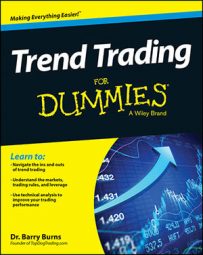Trading doesn’t come with certainties. Successful trading isn’t the ability to tell the future. Professional traders are managers of probabilities. You discover how to put the odds on your side.
As wonderful as trend trading is, you should add a few things to your trading arsenal to improve the probability of your trades succeeding. Putting these elements together constitutes the five-energy methodology.
The first energy is trend (market direction), which is what you look for before taking a trade. Then if you’re interested in buying or shorting the market, you look at the other four energies: strength, timing, support/resistance, and scale.
Evaluating the strength of the trend
You may be able to determine the correct direction of the trend and thus decide whether you want to enter a long or short trade, but that only determines the direction of the market at that snapshot in time. As a trader, the more important question is, “Will the trend continue after I enter the market?”
To answer that question, look at the strength of the trend, which is the second of the five energies. Using a momentum indicator (to get an objective reading of trend strength), determine whether it’s a strong trend or a weak trend.
If the trend is strong, the odds are that it will continue in the direction after you enter the market.
If the trend is weak, the market may or may not continue to trend, and you should probably pass on the trade.
Evaluating the timing of the trend
“The trend is your friend until the end” is a famous quote among traders. The saying exists to remind people that trends don’t last forever, and it’s best to enter a trend early.
Timing is the third energy in the five-energy trading methodology. To determine whether you’re entering a trend early or late, count the waves in the trend. An average trend continues for five waves. To enter early in a trend, take a position only on the first and second retraces in a trend.
Evaluating support and resistance
Support and resistance levels are blockages of market movement. These represent “floors” and “ceilings” for the market to bounce off and comprise the fourth of the market energies.
Commonly used support/resistance levels are significant previous swing highs and lows, Fibonacci numbers, floor trader pivots, the previous day’s high, low, and close, 52-week highs and lows, and round numbers.
Evaluating the same market on a different scale
Before taking a trade, view the market on a longer-term time interval, or scale, which is the fifth energy. For example, if you’re trading a setup on a daily chart (where each bar represents a day of market activity), consult a weekly chart of the same market. You can use this longer-term interval as a filter and take trades only if the momentum indicator on the higher time interval is moving in the direction of the trade you’re considering.

